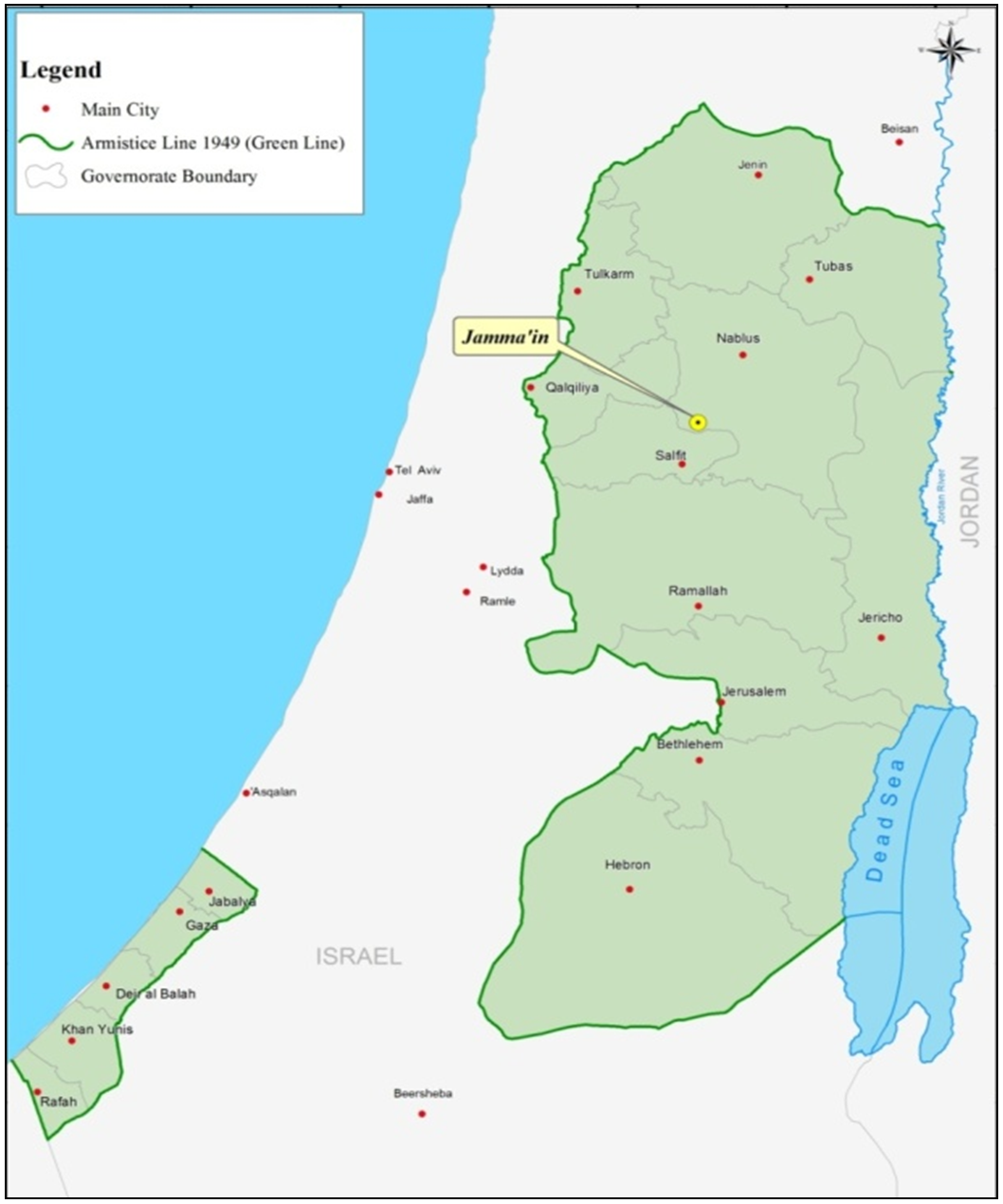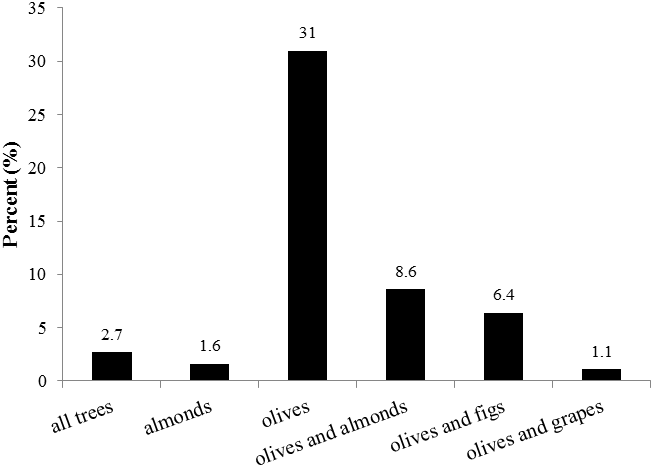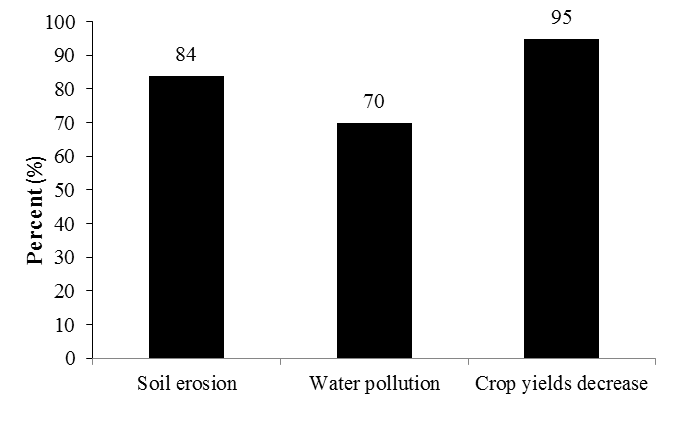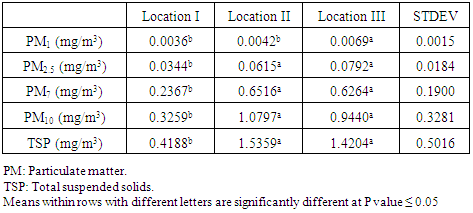-
Paper Information
- Previous Paper
- Paper Submission
-
Journal Information
- About This Journal
- Editorial Board
- Current Issue
- Archive
- Author Guidelines
- Contact Us
Resources and Environment
p-ISSN: 2163-2618 e-ISSN: 2163-2634
2016; 6(6): 122-126
doi:10.5923/j.re.20160606.04

Impact of Air Pollution from Quarrying and Stone Cutting Industries on Agriculture and Plant Biodiversity
Tahseen Sayara 1, Yamen Hamdan 2, Rezq Basheer-Salimia 3
1Environment and Sustainable Agriculture Department, Faculty of Agricultural Science and Technology, Palestine Technical University-Kadoorie, Palestine
2Horticulture and Agricultural Extension Department, Faculty of Agricultural Science and Technology, Palestine Technical University-Kadoorie, Palestine
3Plant Production and Protection, Faculty of Agriculture, Hebron University, Hebron, West-Bank, Palestine
Correspondence to: Tahseen Sayara , Environment and Sustainable Agriculture Department, Faculty of Agricultural Science and Technology, Palestine Technical University-Kadoorie, Palestine.
| Email: |  |
Copyright © 2016 Scientific & Academic Publishing. All Rights Reserved.
This work is licensed under the Creative Commons Attribution International License (CC BY).
http://creativecommons.org/licenses/by/4.0/

More than 300 quarries and 1000 stone cutting industries are exist in Palestine, with a total annual yield of 100 million tons of raw stone and 25 million square meters of good stone. Unfortunately, this industry is usually associated with air pollution. To assess the impact of such action on agriculture and plant biodiversity, two methods including measurement of the particulate matters (PM) as well as a social survey were used in this study. Significant high concentrations of particulate matter/dust as well as total suspended solids (TSP) were presented in the three examined sites located at the northern region of West-Bank, Palestine. This indeed implies the occurrence of high amount of air pollution and dust in the examined areas which significantly exceed the international standards. Furthermore, a notable negative impact of quarrying on plant biodiversity, habitat destruction, and plant survival is also revealed. Based on the questionnaire results and due to quarrying and stone cutting industries, wide range of the plants were affected or even extinct, in which olive was the most affected one with average respondents of 31%. According to the obtained results, it is highly recommended to develop green belt surroundings the quarrying using pollutant-tolerant trees (usually with broad leaves) in order to restrict spreading of quarrying dust via intercepting, filtering and absorbing pollutants.
Keywords: Quarries, Air Pollution, Agriculture, Biodiversity
Cite this paper: Tahseen Sayara , Yamen Hamdan , Rezq Basheer-Salimia , Impact of Air Pollution from Quarrying and Stone Cutting Industries on Agriculture and Plant Biodiversity, Resources and Environment, Vol. 6 No. 6, 2016, pp. 122-126. doi: 10.5923/j.re.20160606.04.
Article Outline
1. Introduction
- Quarrying is a form of land use and part of the local heritage where nonmetallic rocks and aggregates are extracted from land [1]. Dimension and crushed-stones are the final output of such industry in which these products are used for different purposes in our life [2].In Palestine, stone and marble industries (locally named as white-gold) are considered as a successful business. Furthermore, the government as well as the private sector is prioritizing, working heavily, developing and up-scaling this sector.Currently, more than 300 quarries and 1000 factories and workshops exist in Palestine, with a total annual yield of approximately 100 million tons of raw stone and 25 million square meters of good stone. This industry contributes around 4.5% to gross national product (GNP) and 5.5% to gross domestic product (GDP). Total investment in the industry is estimated at around 700 million US$, making it a major employer of Palestinian capital with greater proportion than any of the other Palestinian industries [3]. Internationally, Palestine represents 4% of the world's production of stone and marble. Unfortunately, these activities cause significant impact on the surrounding environment [4]. In fact, the extraction process normally depends on heavy machines and explosives, where both processes are normally associated with air pollution, noise pollution, damage to biodiversity and habitat destruction [5]; in addition to water [6] as well as soil [7].From the agricultural view, released dust not only settles on land, plants and trees but also on surface waters [6], and thus causing various negative impacts on ecosystem as a whole. Furthermore, fertile soil is dislocated and interrupted and after excavation, pits are left unfilled or abandoned leaving big gaping landscape. This is not only unsightly but poses danger to livestock, wildlife and people as well [8].A notable negative impact of quarrying on the environment is also the damage to biodiversity [9], in which plants (vegetation cover) represent the main component of the ecosystem as they are playing a major role in maintaining the balance in the volume of oxygen and carbon dioxide through photosynthetic activities [6]. Such vegetation changes are the main concern of environmental botanists and ecologists in recent years who have advocated the careful and cautious approach to activities promoting such changes [10].The main objective of this study was to assess the impact of quarrying and stone cutting industries on Palestinian eco-system in general including plant biodiversity in particular.
2. Materials and Methods
2.1. The Study Area
- A small village namely Jammain located at the southern region of Nablus city was selected as a study area (Figure 1). The village is about 530 m above the sea with 10,000.00 inhabitants. The selected area is one of the most famous areas of quarrying and stone cutting industries. It has more than 60 quarries and 40 stone cutting industries.
 | Figure 1. Map showing the study area |
2.2. Data Collection
- Two main methods were used to assess the impact of quarries and stone cutting industries on Palestinian agriculture and plant biodiversity. The first includes the measurement of the particulate matters (PM), which was performed using laser-operated portable (OPC; Aerocet 531, MetOne, USA) having five channels (PM1, PM2.5, PM7, PM10 and TSP). This tool is an automatic instrument that estimates PM in a range of 1, 2. 5, 7 and 10 μm in aerodynamic diameters in mass mode, and PM≤0.5 and PM≤10 in count mode. Four measurements were conducted in three different locations with ground distance of 500 to 700 m from the operation sites. The instruments were placed 2-3m above the ground level, and sampling was conducted for one hour in each location. The second method based on a social survey (interview and structured questionnaire) prepared for this purpose.
2.3. Data Analysis
- Data analysis was performed using Chi-square tests for significantly difference (p<0.05) in Statistical Package for Social Sciences (IBM, SPSS, version 15). Microsoft Excel 2007 (Microsoft Office, 2007) was used for calculation and presentation of figures.
3. Results and Discussion
- During the last decades, plant biodiversity and plant survival were subjected to a huge damage by many anthropogenic activities including quarries and stone cutting industries. Toward this end, a notable negative impact of quarrying on the environment is well documented [9], in which they produce large amounts of air pollution which affecting our plants (vegetation cover) that represent the main component of the ecosystem as they are playing a major role in maintaining the balance in the volume of oxygen and carbon dioxide through photosynthetic activities [6].As it shown in Table 1, high concentrations of particulate matter/dust (PM) as well as the total suspended solids (TSP) were presented in the three examined locations. This indeed implies the occurrence of high amount of air pollution and dust in the examined areas which significantly exceed the international standards. For example, the WHO standards for total suspended solids (TSP) is 60 µg/m3, however in the three examined locations, TSP exhibited high significant values of 0.4188 (mg/m3), 1.5359 (mg/m3), and 1.4204 (mg/m3) comparing to the standards. In addition, locations number 2 (1.5359mg/m3) and 3 (1.4204mg/m3) demonstrated high significant values related to the first location. Obtained significances in locations number 2 and 3 could be attributed to the vegetation cover imposed by the intensive different types of trees which blockades and suspended the existent particulate matters and dust comparing to the first location in which grasses and shrubs are dominant implying therefore less vegetation cover (less barriers). Furthermore, these two locations are in parallel with the usual wind direction (North-West) that carrying the particulate matters and dust from the industries to the direction of fruit trees. Similar trend goes also with the particulate matter/dust (PM) throughout the other four (PM1, PM2.5, PM7, and PM10) used channels (Table 1), in which they revealed high concentrations of particulate matter in the three tested locations. It is clear form table 1 that PM10 have the highest concentrations comparing to other measured PM, and this could be attributed to their dispersion at low heights, whereas small PM are normally carried by wind to more heights and later deposited by different sink processes.
|
 | Figure 2. Extinct plants due to quarrying and stone cutting industry |
 | Figure 3. Extinct fruit trees due to quarrying and stone cutting industry |
 | Figure 4. Percentage of respondents about soil erosion, water pollution and crop yields decrease |
4. Conclusions and Recommendations
- Quarrying and stone cutting industries produce high concentrations of particulate matter (dust), which negatively affected agriculture in the study area. The deposition of dust resulted in the extinction of different types of trees and vegetation cover along with reduction in crop yields. Also, these activities affected water and soil which are vital resources for agriculture and thus exacerbating the problem. However, future studies are needed to investigate the impact of such industries on Physiological mechanisms of the plants and the physico-chemical properties of soil and water. According to the obtained results, it is highly recommended to develop green belt surroundings the quarrying using pollutant-tolerant trees (usually with broad leaves) in order to restrict spreading of quarrying dust via intercepting, filtering and absorbing pollutants.
 Abstract
Abstract Reference
Reference Full-Text PDF
Full-Text PDF Full-text HTML
Full-text HTML